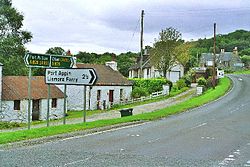Appin
| Appin Gaelic: An Apainn | |
| Argyllshire | |
|---|---|
 Appin village | |
| Location | |
| Location: | 56°33’44"N, 5°21’32"W |
| Data | |
| Post town: | Appin |
| Postcode: | PA38 |
| Local Government | |
| Council: | Argyll and Bute |
| Parliamentary constituency: |
Argyll and Bute |
Appin is a village in Argyllshire and the name of a remote coastal district of the county around the village. It is in the very north of the county, the district bounded to the west by Loch Linnhe, to the south by Loch Creran, to the east by the districts of Benderloch and Lorn, and to the north by Loch Leven, which marks the county boundary.
The area lies northeast to southwest, and is reckoned at 14 miels in length by 7 miles in breadth.
About Appin
The scenery of the coast is beautiful - a combination of seascapes and rugged and mountainous country inland - and Appin forms part of the Lynn of Lorn 'National Scenic Area'. The principal hills are double peaks of Beinn a' Bheithir (3,362 feet and 3,284 feet) and Creag Ghorm (2,372 feet) in the north, and Fraochaidh (2,883 feet), Meall Bàn (2,148 feet) and Beinn Mhic na Céisich (2,093 feet) near the western flank of Glen Creran.
The chief rivers are the Coe and Laroch, flowing into Loch Leven, the Duror and Salachan flowing into Loch Linnhe, and the Iola and Creran flowing into Loch Creran. The leading industries are forestry and tourism, lead mining and slate quarrying and being of former importance but the superquarry Glensanda, in Morvern, on the opposite bank of Loch Linnhe provides employment. Ballachulish, Duror, Portnacroish, Appin Village itself and Port Appin are the principal villages. Appin was the country of a branch of the Stewarts.
There are a number of small settlements in the area. Port Appin, for example has a number of restaurants and a shop.
The A828 road runs along the coast of Appin. A passenger-only ferry to the island of Lismore runs from Port Appin. The district formerly had a railway, but the Caledonian Railway company’s branch line from Connel to Ballachulish was closed in 1966.
Australia
- Elizabeth Campbell of Appin married Lachlan Macquarie, who became the fifth governor of New South Wales. During his term the governor named the towns of Appin and Airds after his wife's birthplace and her family's estate respectively. The Female Orphan School in Parramatta is said to have been modelled on the estate's main house.[1]
Outside links
References
- ↑ "Female Orphan School and Historical Precinct, Parramatta Campus". The Whitlam Institute. Whitlam Institute. 2009. Archived from the original on 11 April 2010. http://web.archive.org/web/20100411031128/http://www.whitlam.org/about_us2/female_orphan_school_precinct. Retrieved 2010-04-28.